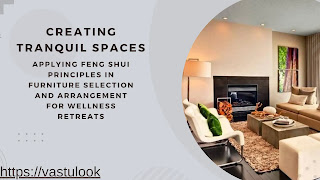Creating Tranquil Spaces:
Applying Feng Shui Principles in Furniture Selection and Arrangement for Wellness Retreats
Introduction
In an increasingly fast-paced and chaotic world, the importance of finding solace and rejuvenation cannot be overstated. Wellness retreats offer a sanctuary for individuals seeking respite from the demands of daily life and an opportunity to reconnect with their inner selves. Integrating Feng Shui principles into the selection and arrangement of furniture in these spaces can greatly enhance the overall experience, fostering a sense of harmony, balance, and positive energy. This comprehensive article delves into the essential Feng Shui guidelines for selecting and arranging furniture in wellness retreats, creating an environment that nurtures physical, mental, and spiritual well-being.
1. The Essence of Feng Shui in Wellness Retreats
Feng Shui, rooted in ancient Chinese philosophy, revolves around the idea that the energy or "Qi" within a space profoundly affects human well-being. In wellness retreats, where individuals seek healing and rejuvenation, the application of Feng Shui principles can amplify the therapeutic experience. Balancing the flow of energy, fostering harmony, and embracing natural elements all contribute to the creation of an optimal environment for relaxation, introspection, and transformation.
2. The Role of Furniture in Feng Shui
Furniture serves as more than mere functional items; it plays a pivotal role in influencing the energetic flow of a space. In Feng Shui, the arrangement of furniture can either facilitate or hinder the movement of Qi. The selection of furniture materials, shapes, colors, and positioning all contribute to the overall harmony and balance of the environment. By carefully considering these factors, wellness retreats can create spaces that encourage healing and self-discovery.
3. The Five Elements and Their Influence
Feng Shui revolves around the concept of five elements—Wood, Fire, Earth, Metal, and Water—each representing specific qualities and energies. Incorporating these elements into furniture selection and arrangement can enhance the overall energy of a wellness retreat:
Wood: Wooden furniture represents growth and vitality. Introduce wooden pieces to promote creativity and flexibility. In retreat spaces, wooden furniture can symbolize the connection between nature and the self.
Fire: Fire elements bring warmth and passion. Use red or fiery colors sparingly in furniture or decor. A balanced representation of fire can kindle enthusiasm and motivation.
Earth: Earth elements embody stability and grounding. Opt for earthy colors like browns and yellows, and include stone or ceramic furniture pieces. Earth elements contribute to a sense of security and rootedness.
Metal: Metal elements signify clarity and precision. Metal furniture pieces or accessories can introduce a sense of elegance and efficiency to retreat spaces. Balance metal with softer elements to prevent an overly sterile atmosphere.
Water: Water elements evoke fluidity and tranquility. Incorporate shades of blue or reflective surfaces to symbolize water's presence. Water elements can enhance the contemplative and calming aspects of a wellness retreat.
YOU MAY LIKE THIS:
4. Furniture Selection: Materials and Textures
The choice of furniture materials and textures significantly impacts the energy of a wellness retreat. In line with Feng Shui principles, prioritize natural and organic materials that resonate with the Earth's elements. Wood, bamboo, rattan, and stone exemplify materials that contribute to a grounding and nurturing atmosphere. These materials connect occupants with the natural world, fostering a sense of tranquility and harmony.
Textures play a role in enhancing tactile experiences and comfort. Soft textures like plush cushions and upholstered seating encourage relaxation, while smoother textures like polished wood or glass surfaces promote clarity and energy flow. The combination of natural materials and thoughtful textures creates an environment that appeals to the senses and invites guests to unwind and rejuvenate.
5. Color Psychology and Feng Shui
Colors wield profound psychological influence and can greatly impact the mood and energy of a space. Feng Shui encourages the use of color to align with the desired energy of a particular area within a wellness retreat:
Calming Spaces: Soft blues and greens evoke feelings of calmness and serenity, making them ideal for meditation and relaxation areas. These colors align with the Water and Wood elements, respectively.
Nurturing Atmospheres: Earthy tones such as sandy beige, warm browns, and soft yellows resonate with the Earth element, promoting a sense of stability and nurturing.
Energizing Zones: For communal spaces or areas where active engagement takes place, consider introducing touches of the Fire element with red or orange accents. These colors can inspire energy, enthusiasm, and social interaction.
Balancing Neutrals: Neutral colors like whites, creams, and soft grays provide a neutral backdrop that complements all elements. They create a canvas upon which other colors and energies can harmoniously interact.
6. Arrangement for Energetic Flow
Incorporating Feng Shui principles into furniture arrangement is essential to promote the flow of positive energy throughout a wellness retreat:
Open Pathways: Ensure that furniture placement does not obstruct natural pathways. Unobstructed pathways facilitate the smooth movement of energy, creating a sense of ease and accessibility.
Command Position: The command position refers to placing key furniture pieces, such as beds or seating, in a spot where occupants have a clear view of the room's entrance. This arrangement promotes a feeling of security and control.
Symmetry and Balance: Symmetrical furniture arrangement fosters visual and energetic equilibrium. Balanced spaces encourage feelings of relaxation and stability.
Zoning: Create distinct zones within the retreat space for various activities such as meditation, reading, and communal interaction. Each zone should have its own unique arrangement that supports its intended purpose.
7. Mindful Placement for Intention
Feng Shui underscores the importance of intention in furniture placement. Mindfully arrange furniture to align with the purpose of each space within the wellness retreat. Meditation areas, for instance, can feature comfortable floor cushions arranged in a circle to encourage group mindfulness sessions. Lounge areas can have cozy seating arranged around a central focal point, promoting relaxation and connection.
 |
| FLOWERAURA |
8. De-Cluttering and Organizational Solutions
Clutter obstructs the free flow of Qi, creating stagnant energy that can hinder well-being. Adopting organizational solutions in furniture design helps maintain clutter-free environments. Furniture with built-in storage compartments provides functional elegance while reducing visual clutter. By incorporating these solutions, wellness retreats can create spaces that nurture both physical and energetic cleanliness.
9. Natural Light and Connection to Nature
Feng Shui places immense importance on natural light and a connection to nature. Arrange furniture to maximize the entry of natural light, ensuring that seating areas and relaxation spots are bathed in sunlight. Position furniture near windows to offer occupants views of natural landscapes, fostering a sense of peace and connection with the outdoors.
10. The Power of Mirrors
Mirrors hold a special place in Feng Shui, as they reflect light and energy, doubling their impact. Mirrors can be used strategically to amplify positive energy or create a sense of expansiveness in smaller spaces. However, care should be taken to avoid placing mirrors directly opposite each other, as this can lead to a chaotic energy bounce.
HELPFUL VIDEO:
Conclusion
The application of Feng Shui principles in the selection and arrangement of furniture for wellness retreats goes beyond aesthetic considerations. It is an artful fusion of ancient wisdom and modern design, creating spaces that resonate with positive energy, tranquility, and rejuvenation. By carefully selecting furniture materials, colors, shapes, and textures that align with the five elements, retreat spaces can be imbued with a sense of harmony and balance. A mindful arrangement that encourages energetic flow, along with intentional placements based on purpose, enhances the holistic experience for retreat participants.
Wellness retreats hold the promise of transformation and self-discovery. Incorporating Feng Shui principles elevates these promises by creating environments that facilitate healing on multiple levels—physical, emotional, and spiritual. Whether through the deliberate selection of furniture materials or the thoughtful arrangement of seating and decor, the fusion of Feng Shui principles and wellness retreats forms a harmonious partnership, inviting individuals to embark on a journey of well-being and inner harmony.
IMAGE SOURCE:https://in.images.search.yahoo.com
 |
Feng shui |










